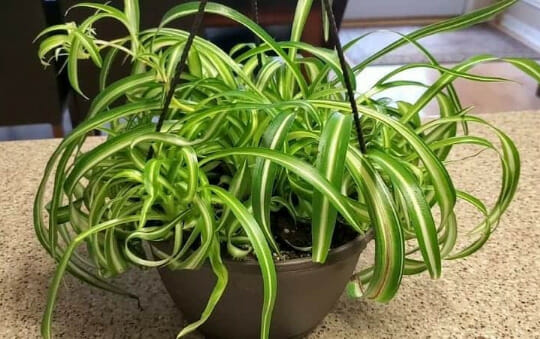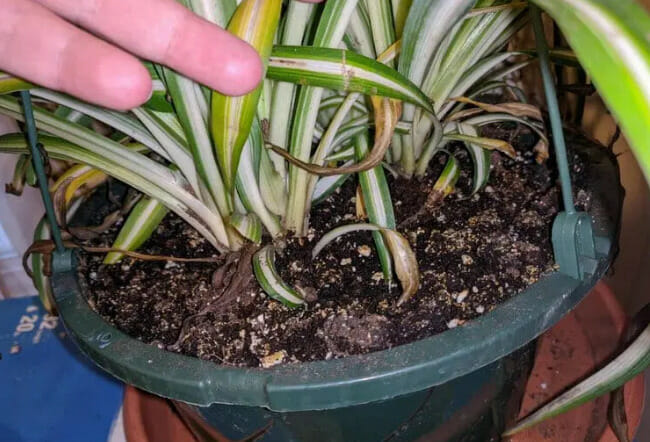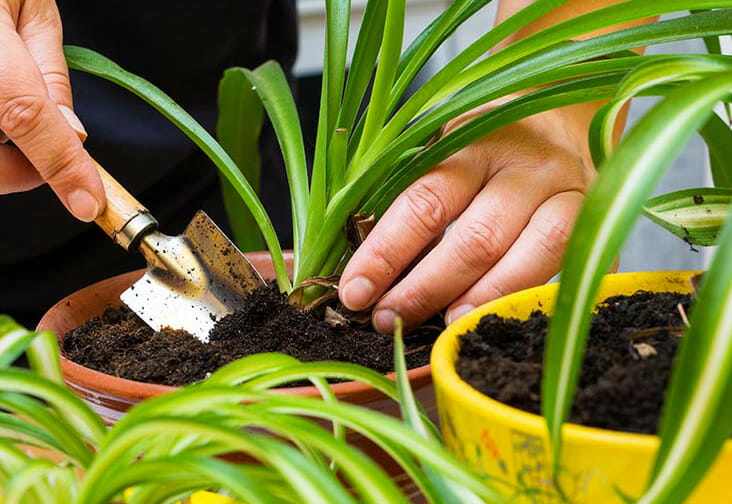Spider plant is one of the most common houseplants. This is usually one of the first choices of beginners as it is an easy-to-care, less demanding, and most adaptable plant. But do you ever wonder, if it is such an easy-going plant, why does it end up dying? There are many factors that can affect the health of your spider plant. In this article, I will answer the most common question in every beginner’s mind: how can you save a dying spider plant?

How To Save A Dying Spider Plant?
You can prevent and manage common problems with your spider plants by paying keen attention to them. Plants might not speak to us, but they do express some apparent signs and symptoms of wilting, which are obvious enough to notice. In this article, we will discuss the signs of spider plants dying, the common reasons causing it, and all the possible solutions you can apply. You can save your dying spider plant once you go through this article.
Look for the Signs:
It is essential to identify the problem before jumping to the solution. The same goes for spider plants. It would help if you looked for the following signs occasionally:
- Yellow and brown discoloration
The most common sign and symptom that your spider plant is not showing healthy growth are that the leaves start to turn yellow. After yellowing, the leaves become brown or black. This change in the color of leaves indicates that you are overwatering the plant, which can lead to root rot.

- Improper growth (Less than usual growth or completely blocked)
Spider plants grow fast provided the care and conditions are proper. If the spider plant shows optimal growth, it produces flowers in spring. The flowers then turn to plantlets which can be propagated. If you feel that your plant’s growth is stunted and not growing after several months, then it is a sign that you must detect the problem before the plant dies.
- Drooping leaves
When the spider plant leaves start to wilt, it could point out various reasons like poor soil quality or lack of proper lighting. If such conditions prevail, then your plant can die after some time.

- Lack of freshness in the leaves
When you notice the spider plant’s leaves looking dull or moving inwards, identify the reason for that. Because it could be due to a lack of enough water or too much dry soil. Since spider plants like moist soil, dry soil for a long time can become a reason for your spider plant’s death.
- Mushy/ soggy soil
If you observe that the soil in your spider plant pot is not drying. In fact, it is soggy all the time. Then it could be due to poor drainage in the pot. Although spider plant likes moist soil, if you keep watering the plants as per routine without proper drainage, then the moist soil can lead to root rot.

- Bad smelling soil
When the pots’ drainage holes are clogged, the water does not drain, and the soil remains moist. Moreover, due to over watering, the soil remains wet and does not get the chance to dry. In such anaerobic conditions, bacteria grow in the soil, causing a bad smell. The excessive moisture also leads to root rot, killing the spider plant.
If you notice these signs in your spider plants, you need to consider working on them to save your dying spider plant.
Reasons Your Spider Plants are Dying
Once you have identified the problems, finding the reasons behind them is crucial so you can take proper action to save the plant. Everybody makes basic mistakes in the care of plants that can be fatal for the plant. Let’s discuss the common reasons that impact the growth of the spider plant leading to their death.
Inappropriate Light
Unlike many other plants, spider plants ideally grow well in indirect light. Whether your plant is placed in a comparatively darker place (where it is not receiving enough light) or in scorching heat, both can be a reason for damaging it. The leaves will turn yellow and gradually brown from the ends towards the roots. Therefore, it is essential to monitor the sunlight for your spider plant.

Solution
Make sure you pick a spot for your spider plant where it only receives as much light as it needs; otherwise, the leaves will start to turn yellow-brown with time. Just keep them at a south-facing place for your ease and ensure that they receive light, particularly when the sun is rising and setting. Your plant receives about 6 hours of indirect sunlight is all you need to do in this regard.
Prevention
- Avoid direct exposure to sunlight.
- Take extra care in summers since the heat and light are much more these days.
- If you have mistakenly placed your plant at such a place, immediately shift it to prevent further damage. Just clip off the yellow edges and take care of the sunlight from now on.
- If there is no proper sunlight, arrange artificial light for the plants.
Excessive Watering
You love your plants a lot, making you want to water them repeatedly. Well, if that’s the case, you need to stop this habit right here.
Overenthusiasm for watering the plants might be a reason for their damage and death. Just water them after planting, occasionally when the soil is dry, and stop watering once it falls from the drainage hole. Spider plants are super accommodating and can handle dry to moist conditions well. However, overwatering is going to do significant harm. Therefore decide the watering regime accordingly.

Solution
If you want to save your dying spider plant, first of all, stop overwatering. If you have overwatered the spider plant, let the water dry. You might also want to repot the plant if it is planted in a pot bigger than the plant; water will stay for days. For the soil to dry well, it is necessary to maintain proper air circulation. Dig into the soil from the top towards the bottom so that more soil gets exposed and dried earlier.
Prevention
- Do not water the spider plant until necessary.
- Pause watering for some time if you have already watered a lot recently.
- Wait for the soil to get dry before watering the next time
- Avoid following a hard and fast watering schedule for all the plants.
- Ensure proper sunlight and air reaches the plant to avoid long-term moisture retention in the soil
Underwatering the Plants
No doubt spider plants cope well with dry conditions effectively, but that doesn’t mean they deserve dehydration. Spider plants still need an adequate amount of water to live. Underwatering for a shorter period might not harm the plant, but if this happens for extended periods, your plant will die.

Solution
Try to remember the last time you watered your plants. If it has been a long time, immediately water them. Clip off the dried-out and yellow parts of the leaves with a pair of scissors. This will direct all the nutrients toward the healthy parts of the leaves. After draining the excess water, you might need to rewater them for better results.
Prevention
- Keep checking the soil for dehydration signs.
- Ensure uniform watering of the pot so you might not habitually miss some parts of the soil.
- Adjust the watering schedule of your spider plants according to the seasonal and weather changes
Significantly Less or a Lot of Fertilizer
Like light and water, adequate fertilizer is also essential for plants’ growth. By having less than the required fertilizer in the soil, the plant would not receive the vital nutrients (Nitrogen, Potassium, and Phosphorous). Similarly, if you overdo the fertilizer, it will retain moisture and keep the soil soggy, which is unsuitable for the spider plant since it thrives well in typical non-moist soil.

Solution
The need for fertilizer varies from soil to soil and plant to plant. Analyze your soil and plants carefully, and then decide the fertilization. Natural fertilizers such as dry leaves and animal dunks do well for spider plants. If you have overfertilized your plant, consider repotting it. Also, balance the concentration of the fertilizer by diluting it with water.
Prevention
- Increase the frequency of fertilizing during summers and decrease it during winters.
- Look for soil cracking and other acidification signs.
- Avoid fertilizing for some time if you find these signs in the plants.
Root Rot
Root rot is a silent killer of your plant. Your plant might be suffering badly inside without showing many signs from outside. So it is crucial to prevent root rot and get rid of it as soon as possible if you want to save your dying spider plant.

Solution
It is recommended to have a look at the roots occasionally. Pull the plant out from the pot and sift through the lower parts. If the roots appear brownish, weak, and mushy, they certainly have a problem.
Put them under plain running water first. Dip the roots in hydrogen peroxide or the dishwasher and neem oil solution. Let them air dry for some time to eliminate any pests and fungi. Cut the damaged roots, so the healthy roots do not get affected. Consider changing the pot if it is not favorable for the plant anymore.
Prevention
- Ensure no excessive water is present in the pot. Even if it is placed at such a spot, the water should be in constant motion.
- Spray insecticidal solution occasionally on the roots and plants, even if they are not infected.
Highly Mineralized Tap water
An excessive amount of the minerals, especially chloride and fluoride (especially in tap water), may also potentially damage your spider plants. Nevertheless, a small amount of these minerals is not harmful. Therefore, keep this issue in consideration as well while you analyze the reasons for the spider plant’s death.

Solution
If the water has a significantly higher amount of these minerals, reduce the amount of fertilizer for the spider plants. However, if this practice does not resolve the issue or your water source is highly salty, consider changing water for your spider plants.
Prevention
- Let the water run slowly and steadily through the soil ( to sift the minerals) while watering the spider plants.
- Keep checking the lower part and outer part of the plant pot for mineral deposits occasionally. If they are suddenly increasing at a higher pace, be cautious about this issue.
Pests and other Micro-Organisms
Although rare, pests can also cause the spider plant death, as in the case of other plants. Spider plants are comparatively resilient to pest infection, but it does not mean they cannot get them. So it is always good to stay on the safe side.
Similarly, fungi like black and white mold can also damage the plant in the long run, so you need to eliminate them. Keep the plant and its pot clean to prevent these conditions.

Solution
Make sure to rule out any pest invasion in your spider plant by careful inspection. Spider mites commonly invade the spider plants, but they are usually missed until the webs appear.
- If the pests are confirmed, mix one tablespoon of the dishwasher and one tablespoon of neem oil in 1 Liter of water. Fill the solution in a spray bottle and then spray it on the plant while paying particular attention to the underside of the leaves. Repeat the activity every three days for up to three weeks. However, be cautious about the leaves reacting negatively to it. In that case, clean them thoroughly with plain water, discontinue this activity, and follow the second method.
- Mix 1 part of rubbing alcohol (precisely 50% isopropyl alcohol) with three parts of water to make an insecticidal solution. Spray it similarly three days apart for 2-3 weeks with a particular focus on the lower parts of the leaves.
Prevention
Spider mites love warm and wet conditions. Lowering the temperature without negatively affecting the plants is impossible, but keeping them dry certainly is. Therefore,
- Improve the air circulation to the soil. Consider using a fan for 1-2 hours a day if the natural air is not enough.
- Humidity on the leaves (not in the soil) is not very favorable for pests. So, you can mist the leaves with plain water to prevent them.
Conclusion:
Love your plant but don’t kill them with your overcaring. Spider plants are easy-going and easy-to-adjust plants. If you are unsure what care they need or have encountered a problem with your spider plants, follow the above solutions and prevention tips. Your plants will undoubtedly stay healthy and rot-free in the long run.
If you like this article, visit our website for more articles on plants, pots, and planters.
Frequently Asked Questions:
Can I save my spider plant by propagating it in water?
You can take out the baby spider plants from the mother plant and put them in a jar of water. After some time, the roots will appear. Spider plant thrives well in soil, so after the development of roots, you can transform them into a pot to get nourishment from soil and fertilizer.
How do you tell if a spider plant is overwatered or Underwatered?
Overwatered soil looks soggy and wet when you touch it. Moreover, the overwatered leaves of the spider plant start to turn yellow. And new leaves start falling off. In comparison, underwater soil is dry and light. Underwatering leads to shock in spider plants, and the leaves start to wilt.
Does pruning make spider plants healthy?
Trimming the damaged leaves and tips makes plants healthy, encouraging more growth of new leaves. Just snip off the discolored leaves and tips with sharp scissors at an angle.
Can Spider Plants Live Outdoors?
Spider plants are not low-light plants. They prefer indirect light. If you put your spider plant outside in a shaded area where it will receive sufficient indirect sunlight, it will thrive.
